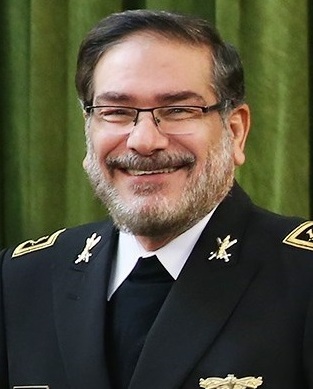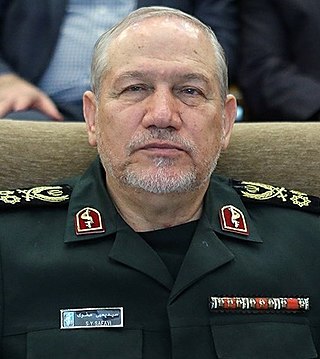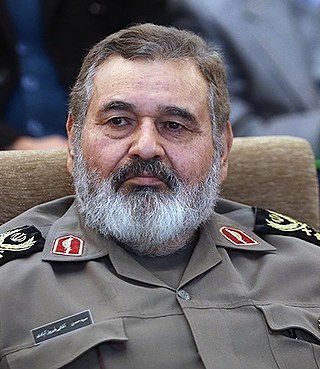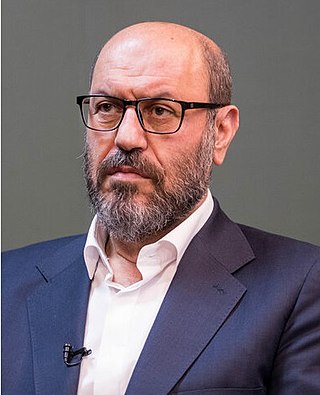
Ali Shamkhani is an Iranian rear admiral upper half. He served as the secretary of the Supreme National Security Council of Iran from 2013 to 2023. He is currently member of the Expediency Discernment Council and political advisor of Supreme Leader of Iran since May 2023.

The Islamic Revolutionary Guard Corps, also called Sepah or Pasdaran, is a multi-service primary branch of the Iranian Armed Forces. It was officially established by Ruhollah Khomeini as a military branch in May 1979, in the aftermath of the Islamic Revolution. Whereas the Iranian Army protects the country's sovereignty in a traditional capacity, the IRGC's constitutional mandate is to ensure the integrity of the Islamic Republic. Most interpretations of this mandate assert that it entrusts the IRGC with preventing foreign interference in Iran, thwarting coups by the traditional military, and crushing "deviant movements" that harm the ideological legacy of the Islamic Revolution. Currently, the IRGC is designated as a terrorist organization by Bahrain, Saudi Arabia, Sweden and the United States.

The Basij, Niru-ye Moghāvemat-e Basij, full name Sâzmân-e Basij-e Mostaz'afin, is one of the five forces of the Islamic Revolutionary Guard Corps (IRGC). The force is named Basij; an individual member is called basiji in the Persian language. As of July 2019, Gholamreza Soleimani is the commander of the Basij.

Yahya "Rahim" Safavi is an Iranian military commander who served as the chief commander of the Islamic Revolutionary Guard Corps.

The Islamic Revolutionary Guard Corps Ground Forces, acronymed NEZSA, are the land force which the Islamic Revolutionary Guard Corps (IRGC), maintain in parallel to the regular army of Iran. In addition to their conventional military role, the revolutionary guards' ground forces are more geared towards internal disorder than the regular army. However, in late years, the IRGC Ground Forces and by extension the entire IRGC, have transitioned to becoming an expeditionary force, capable of projecting power abroad, through conventional military operations or via proxies and unconventional warfare. There are at least around 150,000 IRGC Ground Force troops.

Ali Sayyad Shirazi was an Iranian regular military (Artesh) officer. He served as commander of the Ground Force during Iran–Iraq War. He was assassinated by Mojahedin-e Khalq in 1999 while serving as the deputy chief of the Iranian Armed Forces General Staff.

The Iranian Armed Forces, officially the Islamic Republic of Iran Armed Forces, are the combined military forces of Iran, comprising the Islamic Republic of Iran Army (Artesh), the Islamic Revolutionary Guard Corps (Sepah) and the Law Enforcement Force (Faraja).
The Rank insignia of the Iranian military are the ranks used by the Islamic Republic of Iran Armed Forces (IRIAF). The armed forces are split into the Islamic Republic of Iran Army and the Islamic Revolutionary Guard Corps. The ranks used by the Law Enforcement Forces share a similar structure to the military.

Sayyid Hassan Aghaee Firouzabadi was an Iranian military officer. He served as the Chief-of-Staff of the Iranian Armed Forces—the most senior military authority in Iran—from 1989 to 2016. After that, he was appointed as a senior military advisor to the Supreme Leader of Iran and a member of the Expediency Discernment Council.

Ahmad Kazemi was an Iranian commander in the Islamic Revolutionary Guard Corps and one of the most notable commanders in the Iran–Iraq War.

The Supreme Leader of Iran ), also referred to as Supreme Leader of the Islamic Revolution, but officially called the Supreme Leadership Authority, is the head of state and the highest political and religious authority of the Islamic Republic of Iran. The armed forces, judiciary, state television, and other key government organisations such as the Guardian Council and Expediency Discernment Council are subject to the Supreme Leader. According to the constitution, the Supreme Leader delineates the general policies of the Islamic Republic, supervising the legislature, the judiciary, and the executive branches. The current lifetime officeholder, Ali Khamenei, has issued decrees and made the final decisions on the economy, the environment, foreign policy, education, national planning, and other aspects of governance in Iran. Khamenei also makes the final decisions on the amount of transparency in elections, and has dismissed and reinstated presidential cabinet appointees. The Supreme Leader is legally considered "inviolable", with Iranians being routinely punished for questioning or insulting him.

Hossein Dehghani Poudeh, commonly known as Hossein Dehghan, is an Iranian military officer and former IRGC Air Force officer with the rank of brigadier general. He is currently head of the Mostazafan Foundation since 2023.

Hossein Salami is an Iranian military officer with the rank of major general, who is the commander-in-chief of the Islamic Revolutionary Guard Corps (IRGC).

Mohammad Bagheri (Persian: محمد باقری, born Mohammad-Hossein Afshordi is an Iranian Islamic Revolutionary Guard Corps military commander serving at the most senior military position available in Iran, Chief of Staff for the Armed Forces of the Islamic Republic of Iran. He holds the rank of Major General within the Iranian military.

The position of Commander-in-Chief (Farmandehe Koll-e Qova, formerly known as Bozorg Arteshtārān is the ultimate authority of all the Armed Forces of Iran, and the highest possible military position within the Islamic Republic of Iran. The position was established during the Persian Constitutional Revolution. According to the Constitution of Iran, the position is vested in the Supreme Leader of Iran and is held since 1981.

Mohammad Bagher Zolghadr is an Iranian retired military commander in the Islamic Revolutionary Guard Corps who currently serves as the Secretary of the Expediency Discernment Council. Also he is currently member of the Expediency Discernment Council.

Abbas Mohtaj is an Iranian military officer and politician.
Second brigadier general is a senior military rank in the armed forces of Iran. The rank was introduced in 1987 as part of a new modified ranking system. Currently, there is no equivalent for the rank of second brigadier general in other countries but the rank of second brigadier general lies under the NATO equivalent code of OF-6. It is the lowest ranking general officer rank in the armed forces of Iran and lies between the ranks of colonel and brigadier general. However, the equivalent rank in the Iranian navy is the rank of Second flotilla admiral.

Esmail Qaani is an Iranian brigadier general in the Islamic Revolutionary Guard Corps and commander of its Quds Force — a division primarily responsible for extraterritorial military and clandestine operations. Leader of Iran Ali Khamenei appointed Qaani to succeed Qasem Soleimani as Commander of the Quds Force.


































